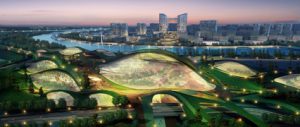If you visited a construction site in California over the past decade, the chances are good it incorporated some degree of sustainable building practice. That’s no surprise for Californian builders. Long a leader on environmental issues such as fuel efficiency and energy reduction, the state has also been ahead of the game in green building practices: California accounted for 15% of all US buildings certified under the global green rating system LEED (Leadership in Energy & Environmental Design) registered with the US Green Building Council in 2009.
But with the launch of a new, landmark building code on January 1 this year – CALGreen – California has taken a major step toward greater sustainability. It now has the greenest building standard of any state in the country (green building codes have previously been adopted by US cities, but this is the first to be taken up statewide). And crucially, it is mandatory. Now that California has taken the plunge, will other states follow and institute similar compulsory codes? Can California’s example help to drive greener building practices abroad?
For new buildings constructed in the state, CALGreen requires a number of sustainability measures. Included in the code is a mandatory reduction in water consumption — 20% below the requirement in the previous California Buildings Standards Code — as well as the use of low pollutant-emitting paint, carpets, floorings and other materials. It also requires that 50% of construction waste be diverted from landfill and energy-system inspections be conducted by local officials to ensure heating, ventilating and air-conditioning systems meet efficiency standards.
With buildings accounting for 40% of energy consumption in the United States, and the building materials industry a further 12%, officials in California are looking to their new code to help the state meet its goal of cutting greenhouse-gas emissions to below 1990 levels by 2020 – and by 80% below 1990 levels by 2050. The code is also expected to reduce construction waste bound for landfill, currently estimated at 2.5 to four tonnes for an average home.
CALGreen is similar in scope to LEED – the world’s best known green building rating tool – but there is a crucial difference. While LEED is a voluntary performance standard that awards certificates for good practice, California’s new system is compulsory: green standards are actually written into the state’s building code. “The impact of CALGreen is huge,” says Walker Wells, architect and green urbanism programme director at environmental NGO Global Green USA. “It makes official all of these things that were once exotic…It says green has become part and parcel of the way buildings are designed and built in the state of California, and it’s setting a precedent for the nation.”
According to David Walls, executive director of the California Building Standards Commission, the body that developed CALGreen, the code has turned out to be a milestone for sustainable building practices. “No other state or city has actually developed or adopted a green building code,” said Walls. “Some of them have adopted LEED-based programmes, but none are getting out there and mandating specific requirements like we have. A lot of people have said it’s a really big push in the right direction.”
Many hope that this “push” will spread beyond California’s borders in the years ahead. “People got comfortable with LEED and started taking it for granted,” says Abhishek Lal, programme manager for Architectural Energy Corporation in Washington, DC. “CALGreen forces people to take another look, and challenges business as usual. I think CALGreen resets the goals with green building that other regions in the US are not doing.”
CALGreen could also offer a blueprint for other countries. Internationally, some cities, such as Dubai and Singapore, have adopted compulsory codes but most regions rely on voluntary certification systems to drive green building practices: in addition to LEED, there are a wide range of available, overlapping and sometimes conflicting standards, such as the BRE Environmental Assessment Method (BREEAM) – devised in the United Kingdom in 1990 and now widely used across Europe – and Green Star in Australia.
In China, the Ministry of Housing and Urban Development (MoHURD) in 2006 established the Three Star rating system, another voluntary programme, under which buildings are awarded one, two or three stars, according to six components: land efficiency, energy efficiency, water efficiency, resource efficiency, environment quality and operational management.
“The green building industry in China is growing quickly,” said Zhai Chaoqin, technical director at green building consultancy EMSI Asia. “The certification market is mainly shared by two rating systems: China Green Building Design Label [Three Star] and LEED, while other systems such as Green Mark are pursued by a few projects.”
A relative newcomer to the green building certification field, the Three Star system has gained quick penetration into the Chinese market since its implementation, according to Zhai. As of October 2010, it had 54 certified projects. However, MoHURD officials have warned that widespread adoption of the Three Star system is limited by several factors: a lack of technological integration, a need to improve and expand the standards to cover more public buildings and potential conflicts between local and national green building standards.
One way for countries such as China to make the fragmented green building market more effective may be to move to a single codified standard in the manner of CALGreen, though this may still be a way off. “So far, I have not seen any move from the government in codifying the green building standard,” said Zhai. “The industry in China has not become aware of CALGreen.”
Today, LEED remains the default standard for green builders in China, especially since many green buildings in the country tend to be major projects located in large urban areas, often with international designers or consultants. For example, the nearly completed Pearl River Tower in Guangzhou is reputed to be one of the most energy-efficient skyscrapers in the world, with integrated wind turbine generators for powering the building’s heating, ventilation and air conditioning systems. It is also designed by Chicago-based architectural firm Skidmore, Owings and Merrill (SOM).
“We’re seeing recognition of LEED in China in terms of a way to evaluate the basis of performance on design,” said Mark Sarkisian, director of structural engineering at SOM’s San Francisco office. “We’re doing some projects now where clients have asked us to meet certain LEED standards. They’re looking at the US in terms of the green initiatives we’ve done so far, including LEED.”
Sarkisian added that sustainable building is an important issue in China, with many of SOM’s Chinese clients and local authorities interested in taking design to LEED levels. “We’ll be doing some urban planning work for entities in China that are dealing with sustainability issues on a much broader scale,” he said.
Besides China’s development of Three Star, collaborations with international design and consultancy firms will further raise green building standards in the country in the years ahead. “With the development we see there and the development to come, China has a great opportunity to move forward with green building benchmarks that are very high,” said Sarkisian. “There are firms from the US that see the opportunity to really try to do that, and I think it’s going to happen. Things are happening at a very great scale. And if Chinese and foreign design firms continue to push these sustainable building ideas, there’s going to be a significant effect on the built environment.”
If the United States can make compulsory green building standards the norm, this effort may be significantly strengthened.
John Anderson is a freelance journalist based in California.
Homepage image from Artifan shows San Diego, California.


